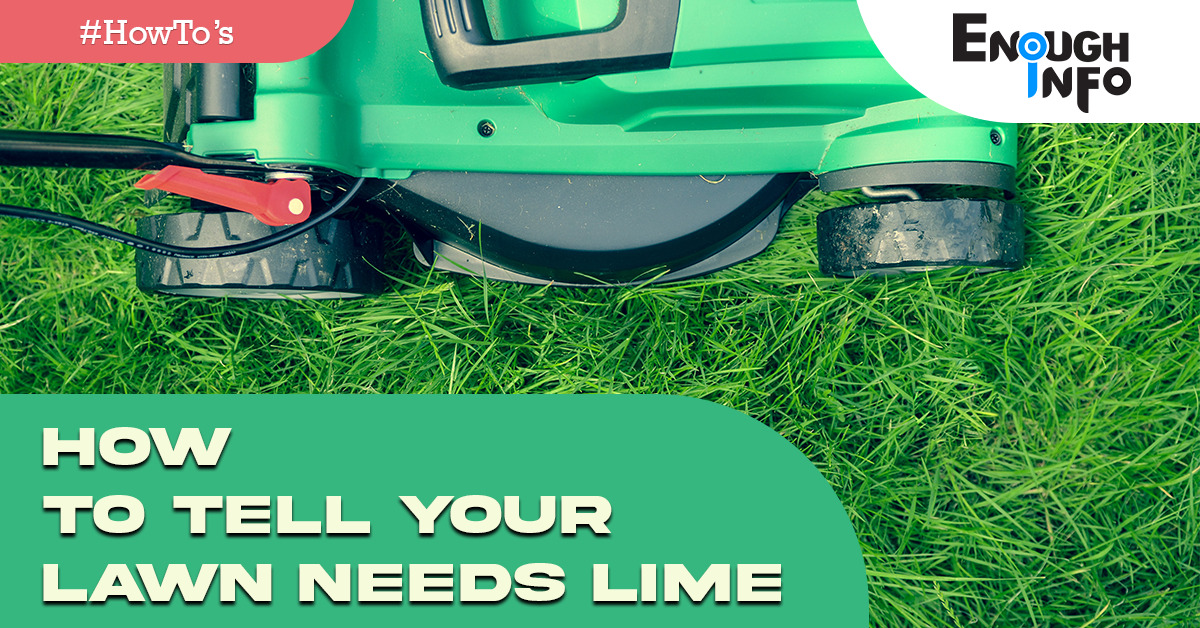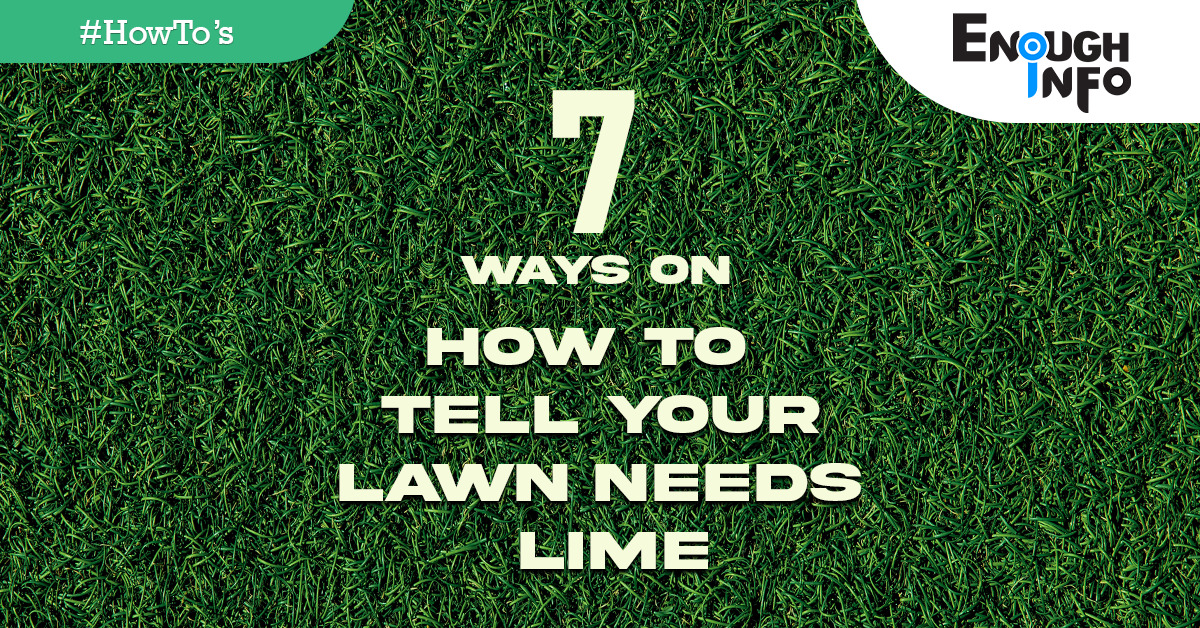How To Tell Your Lawn Needs Lime

How To Tell Your Lawn Needs Lime: Applying lime to your lawn is probably necessary if it has yellowing or weed-infested grass and fertilizers don’t appear to be helping. If your lawn is excessively acidic, which prevents grass growth, you should do a soil pH test to find out why. By applying a lime treatment to your lawn, you may change the pH balance of the soil, making it more nutrient-absorbent and hospitable to plants. Keep Scrolling. EnoughInfo.com

If you’re new to lawn care, finding a million year-round lawn care ideas might be overwhelming. Even though we all have different lawn tastes, we can all agree that a lush, green, healthy lawn makes neighbors envy. BRICS: A New Currency (All You Need To Know)
Read Also: How To Get Rid Of Stink Bugs(All You Need To Know)
Before buying fertilisers and weed killers that may damage your soil, consider a lime treatment. A little research, testing, and understanding how to tell whether your lawn needs lime will assist. Well-limed grass requires less fertiliser and repels weeds.
Lime treatments can help your grass recover nutrients lost to acidity and repair damage. Can you tell whether your lawn needs lime?
What is lime?
Pulverized limestone is used as a soil additive to create lime. It includes the substance calcium carbonate, which adds calcium to the soil and lessens soil acidity. The usage of ground limestone, a natural, non-toxic substance, is widespread in agriculture. Your grass also gains significantly from it. AI And Blockchain: How They Work Together
The two varieties of lime that are often offered for sale are:
- Calcite Lime: Calcite lime, regarded as the “standard” agricultural lime, includes high quantities of calcium as a soil acidity-lowering agent. How To Know If She Is The One
- Dolomitic lime: This will lessen soil acidity and has substantially greater magnesium concentrations than calcite lime.
In the end, calcitic limestone and dolomitic limestone will both provide the outcomes you want for your grass. Most of the time, we advise choosing the least expensive lime product since large-scale agricultural enterprises have particular calcium and magnesium demands that are more important to meet than increasing the health of a lawn.
Read Also: How To Get Rid Of Rust (8 Good Methods)
FAQs & Answers on How To Tell You Lawn Needs Lime
1. When is the best time to apply lime to a lawn?
Early spring or late autumn are often the ideal times to apply lime to a grass. Before the active growth season starts or restarts, these seasons provide the lime adequate time to react with the soil and correct the pH. Applying lime during times of drought or high heat is typically not advised.
2. Can I apply lime to my lawn if it already has grass seed or fertilizer?
A lawn with grass seed or fertiliser can be limed. However, spacing applications is advised. Lime can be administered before or after sowing, however fertiliser should be applied many weeks apart. Follow the lime and fertiliser recommendations for specifics.
3. How long does it take for lime to work on a lawn?
Lime works on lawns differently depending on soil makeup and pH levels. Lime reacts with soil and adjusts pH over several months. Be patient and watch the lawn grow. Lime treatments can be determined through soil testing.
How to tell your lawn needs lime

1. Yellow Grass
Soils with a pH between 5.8 and 7.0 are ideal for lawn grass growth (the lower the pH, the more acidic the soil is). Plants and grasses are unable to efficiently draw nutrients from the soil when the pH of the soil is too low and it becomes too acidic. There is a very strong possibility you need to apply lime if your grass is yellowing, dying in areas, or growing poorly despite your lawn care efforts.
Over time, natural nutrients are drained from the soil by processes including water runoff and the use of certain fertilizers, which causes soils to become more acidic. The soil’s acidity has likely increased if nothing else in your routine for maintaining your lawn has altered yet your grass is suffering more than ever. Android Engineer Job Description
2. Fertilizers Don’t Have a Good Effect
Naturally, the first thing that springs to mind when a lawn seems sickly is lawn fertilizer. I like lawn maintenance and would want to see a healthy lawn. Our natural instinct is to provide nutrients to our grass to promote growth.
Even more fertilizing won’t make a difference if your soil is excessively acidic for your grass, however. High soil acidity prevents plants from absorbing nutrients, and over fertilization with substances like a may even make the soil more acidic. When fertilizers are ineffective, you should think about liming your grass. How AI Voice Cloning Works And How To Use It
3. Grass with moss
Mosses enjoy acidic soil much as weeds do. Look in wet, shady regions. It might be a clear sign that your lawn needs lime treatment if you see moss spreading out from the base of your trees and onto the major areas of your grass. How To Use Boveda Packs (Tips)
4. Clay or Sandy Soil
Some kinds of soil are by nature more acidic. While sandy soil promotes runoff that may remove calcium and other pH-balancing substances from the soil, clay soils tend to be more acidic. Your lawn probably requires lime if it was constructed on one of these soil types. You should add lime to sandy soil every two to three years to maintain healthy grass growth.
Read Also: Health Benefits Of Pomegranates (Step By Step)
5. You Experience a Prolonged Torrential rain
Excessive rainfall may need the addition of lime to your lawn, whether it’s due to an unusually wet winter on the west coast, a flurry of storms in the south, or a soggy spring in the northeast. Calcium and magnesium are naturally removed from the soil by water, raising the pH level. You’ll need to apply lime to your lawn to counteract increased soil acidity if you’ve recently seen extreme weather patterns or live in an area with a lot of precipitation. How To Study In Canada From Nigeria(All You Need to know)
6. Inadequate drought recovery
Even when soil acidity increases, a well-kept lawn might sometimes put up a good appearance. However, if your lawn experiences stress from a dry spell or a period of extreme heat and doesn’t recover, it’s an indication that lime treatment is necessary. Grass need more nutrients to recuperate from a drought, but acidic soil can suffocate the plants. Prepare to apply lime in the autumn if your grass struggles to survive the summer.
7. Infestation of weeds
In an acidic soil, many weeds grow well. One of the most prevalent and aggressive weeds, dandelions thrive on acidic soils. It’s probably time to lime your lawn if you’ve observed a spike in weeds growing amid your grass. This will help drive these invasive plants out. How Are Multiple Sclerosis And Atherosclerosis Similar
How to Detect Soil pH
Starting from the ground up is how to grow a healthy grass (literally). The pH scale measures how basic or acidic a something is. Because it affects how many nutrients plants and grass can receive from the soil, soil pH is vital to take into account while growing plants and grass.
Less nutrients will be available in your soil as it becomes more acidic, which will provide the ideal conditions for weed growth and grass death. Plants prefer a pH balance between 0 and 14, where 0 is the most acidic and 14 is the most basic.
For the optimum development of grass, you should be between a 6.5 and a 7.0. Sending a sample to a lab, utilizing a soil pH meter, or doing it yourself with a few supplies from around the house are all options for checking the pH values in your soil. Consider these steps if you decide to do it yourself: Product Owner Job Description
Read Also: How To Get Rid Of Fruit Flies (Step by Step)
What is required
- Vinegar
- Baking soda
- Two plastic containers
- Cup for measuring
- Water IT Consultant Job Description
How to do a pH test
- One cup of dirt should be taken from your yard and divided between the two plastic pots.
- One of the containers should contain 1/2 cup of vinegar. You have a more fundamental dirt if it sizzles.
- If the dirt in the first container does not sizzle, add roughly two teaspoons of water to the soil in the second container until it is muddy. How To Naturally Manage Menopause Symptoms (13 Remedies)
- Add 1/2 cup of baking soda to the second container, which is now covered with muck. You have a more acidic soil if it sizzles.
- Your soil is neutral (lucky you!) if neither container of soil responds to the vinegar or baking soda.
Read Also: How To Get Rid Of Mice( All You Need To Know 2023)
Conclusion
Applying lime to your lawn can help maintain it lush and green all year long. It’s time to add lime to your lawn if you see yellowing of the grass, trouble initiating new growth, or low pH levels in your soil test results. Healthcare Data Analyst Job Description
Recommended;
15 Effective Home Remedies For Gastritis (2023 Guide)
How Does Cystic Fibrosis Affect Intellectual Development?
How To Tell The Difference Between Cellulose And Asbestos Insulation




